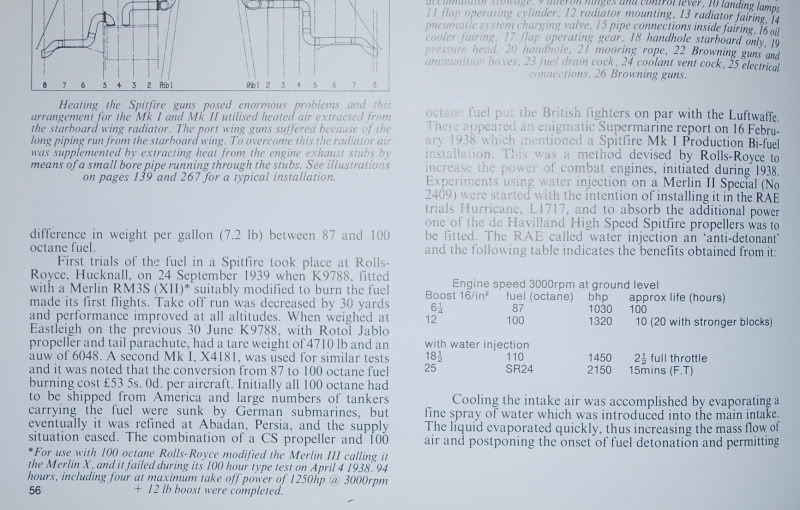
 |
|
#131
|
|||
|
|||
 There are several errors in the above excerpt. The Merlin X had a two stage SC and was not a Merlin III modified to run on 100 octane. British Tanker losses in the first year of the war were quite low. OTOH, it shows clearly that the Merlin III could be run for long periods of time at 12lb/3000rpm. 10 hours in 1938 engines and 20 hours in later engines. Last edited by Seadog; 06-17-2011 at 07:37 PM. |
|
#132
|
|||
|
|||
|
http://i38.photobucket.com/albums/e1...00octane_1.jpg
and this is a prewar planning document, and we all know that RAFFC made a wholesale conversion to CS props and 100octane fuel in the spring of 1940 in response to wartime events, especially the improved performance of the Me109. Conversion to 100 octane without changing over to CS props was almost pointless, but a March 1939 planning meeting could not have envisaged the largescale changes that would be required by Spring 1940. |
|
#133
|
|||
|
|||
|
Quote:
The second paper is the actions from the 5th meeting of the Oil Committee for the 6th Meeting. Here the statment is quite clear that Blenheim units in No 2 Group were to switch to 100 Octane. The previous two papers I posted highlighted that four stations were to be totally equipped with 100 Octane and the others were to keep one tank of 87 Octane. I should add that these were from the 6th meeting of the Committee. I should also add another paper from the 7th Meeting of the Oil Committee where they confirm that the fighter units concerned had been stocked with the 100 Octane Fuel and that the Air Minestry had been impressed with the way that the task had been handled. You can of course read those previous papers how you wish, but to me when it says to keep one sixth of the fuel as 87 Octane and five sixths 100 Octane and we know that some of that 87 Octane is for visiting aircraft then operations are going to be on 100 Octane. Put all the papers together they tell me that all Blenheim units in No 2 Group are going to use 100 Octane on operations. I emphasise all, not two squadrons. You may well consider me to be childish but I have produced original documentation to support my case. Last edited by Glider; 06-17-2011 at 10:16 PM. |
|
#134
|
||||
|
||||
|
Quote:
However it clearly states that Fighter Command was still not clear whether or not 100 Octane could even be used in Hurricane and Spitfire aircraft. Quote:
|
|
#135
|
|||
|
|||
|
Quote:
In the Summary of Conclusions of the 6th Meeting the following action was given to RDE 1 who was a Mr Tweedie, the action being to clarify the position with Fighter Command. In the 7th Meeting it was noted that the use of this fuel had been made clear to Fighter Command and that the Units had been equipped with the 100 Octane Fuel. |
|
#136
|
|||
|
|||
|
Quote:
|
|
#137
|
||||
|
||||
|
Quote:
|
|
#138
|
||||
|
||||
|
Quote:
What are the units concerned? |
|
#139
|
|||
|
|||
|
It doesn't say but its a common phrase to say in this situation. We do know that the Chief of the Air Staff had asked for fighter units to be equipped with 100 Octane. This request wasn't limited to Group or squadron or any other kind of boundary so I believe that the units concerned are the Fighter units.
I admit that its the sort of ambiguity that some people will try to build a lot on, but I cannot help what a senior civil servant wrote down seventy years ago and have to live with the consequences. |
|
#140
|
|||
|
|||
|
Quote:
There's no uncertanity in here. You simply misquote the document. Gilder, do you have the complete file?
__________________
Il-2Bugtracker: Feature #200: Missing 100 octane subtypes of Bf 109E and Bf 110C http://www.il2bugtracker.com/issues/200 Il-2Bugtracker: Bug #415: Spitfire Mk I, Ia, and Mk II: Stability and Control http://www.il2bugtracker.com/issues/415 Kurfürst - Your resource site on Bf 109 performance! http://kurfurst.org 
Last edited by Kurfürst; 06-18-2011 at 01:58 PM. |
 |
|
|